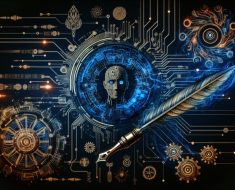
It is becoming increasingly clear that the advent of artificial general intelligence (AGI) is upon us. OpenAI includes in its mission that it “aims to maximize the positive impact of AGI while minimizing harm.” The research organization recognizes that AGI won’t create a utopia, but they strive to ensure that its benefits are widespread and that it doesn’t exacerbate existing inequalities.
Some say that elements of AGI will be seen in GPT-5 that OpenAI says is currently in prerelease testing. GPT-5 is anticipated to be available by the end of this year or in 2025.
Others suggest that Magic AI, the expanding artificial intelligence (AI) developer and coding assistant, may have already developed a version of AGI. With a staggering ability to process 3.5 million words, Aman Anand writes in Medium, “It is important to remember that Magic’s model is still under development, and its true capabilities and limitations remain to be seen. While the potential for AGI is undeniable, it is crucial to approach this future with caution and a focus on responsible development.”
Meanwhile Google Gemini 1.5 Pro version is leaping ahead of OpenAI models with a massive context capability:
“This means 1.5 Pro can process vast amounts of information in one go—including 1 hour of video, 11 hours of audio, codebases with over 30,000 lines of code or over 700,000 words. In our research, we’ve also successfully tested up to 10 million tokens.”
Accelerated by the intense competition to be the first to achieve AGI, it is not unreasonable to expect that at least certain of the parameters commonly describing AGI will conceivably be achieved by the end of this year, or almost certainly by 2026. AI researchers anticipate that
“an AGI system should have the following abilities and understanding:
- Abstract thinking.
- Background knowledge.
- Common sense.
- Cause and effect.
- Transfer learning.
AI researchers also anticipate that AGI systems will possess higher-level capabilities, such as being able to do the following:
- Handle various types of learning and learning algorithms.
- Create fixed structures for all tasks.
- Understand symbol systems.
- Use different kinds of knowledge.
- Understand belief systems.
- Engage in metacognition and make use of metacognitive knowledge.”
Given those characteristics, let’s imagine a time, perhaps in four or five years, in which AGI has been achieved and has been rolled out across society. In that circumstance, it would seem that many of the jobs now performed by individuals could be more efficiently and less expensively completed by agents of AGI. Perhaps half or more of all jobs worldwide might be better done by AGI agents. At less cost, more reliability and instant, automatic updating, these virtual employees would be a bargain. Coupled with sophisticated robotics, some of which we are seeing rolled out today, even many hands-on skilled jobs will be efficiently and effectively done by computer. All will be immediately and constantly updated with the very latest discoveries, techniques and contextual approaches.
AGI is expected to be followed by artificial superintelligence (ASI):
“ASI refers to AI technology that will match and then surpass the human mind. To be classed as an ASI, the technology would have to be more capable than a human in every single way possible. Not only could these AI things carry out tasks, but they would even be capable of having emotions and relationships.”
What, then, will individual humans need to learn in higher education that cannot be provided instantly and expertly through their own personal ASI lifelong learning assistant?
ASI may easily provide up-to-the-minute responses to our intellectual curiosity and related questions. It will be able to provide personalized learning experiences; sophisticated simulations; personalized counseling and advising; and assess our abilities and skills to validate and credential our learning. ASI could efficiently provide recordkeeping in a massive database. In that way, there would be no confusion of comparative rankings and currency of credentials such as we see today.
In cases where we cannot achieve tasks on our own, ASI will direct virtual agents to carry out tasks for us. However, that may not fully satisfy the human-to-human and emotional interactions that seems basic to our nature. The human engagement, human affirmation and interpersonal connections may not be fulfilled by ASI and nonhuman agents. For example, some tasks are not as much about the outcome as they are the journey, such as music, art and performance. In those cases, it is the process of refining those abilities that are at least equal to the final product.
Is there something in the interpersonal, human-to-human engagement in such endeavors that is worthy of continuing in higher education rather than solely through computer-assisted achievement? If so, does that require a university campus? Certainly, the number of disciplines and therefore the number of faculty and staff members will fall out of popularity due to suppressed job markets in those fields.
If this vision of the next decade is on target, higher education is best advised to begin considering today how it will morph into something that serves society in the fourth industrial revolution. We must begin to:
- Assess each of the fields for which we prepare students or aspire to prepare students.
- Monitor the uptake of GenAI, AGI and ASI in those fields for the purpose of greater efficiencies and prospective layoffs/changes in hiring.
- Avail ourselves of AI-driven predictive analytics to anticipate the shift in employment patterns.
- Engage with business and industry to assess their anticipated needs.
- Engage our university community to ideate potential value-added aspects that higher education could offer to new and emerging markets using our expertise and facilities.
- Test our ideas through AI-powered analysis and projections.
- Adapt our hiring today and employ upskilling/reskilling to best prepare current staffing for the future.
Have you and your colleagues begun to consider the question of what you provide that could not be more efficiently and less expensively provided by AI? Have you begun to research and formulate plans to compete or add value to services that are likely to be provided by AGI/ASI? One good place to begin such research is by asking a variety of the current generative AI apps to share insights and make recommendations!



